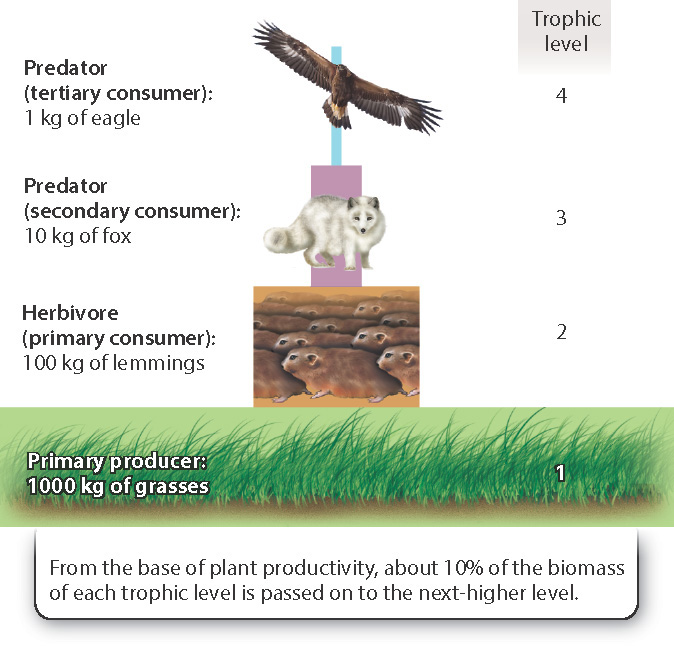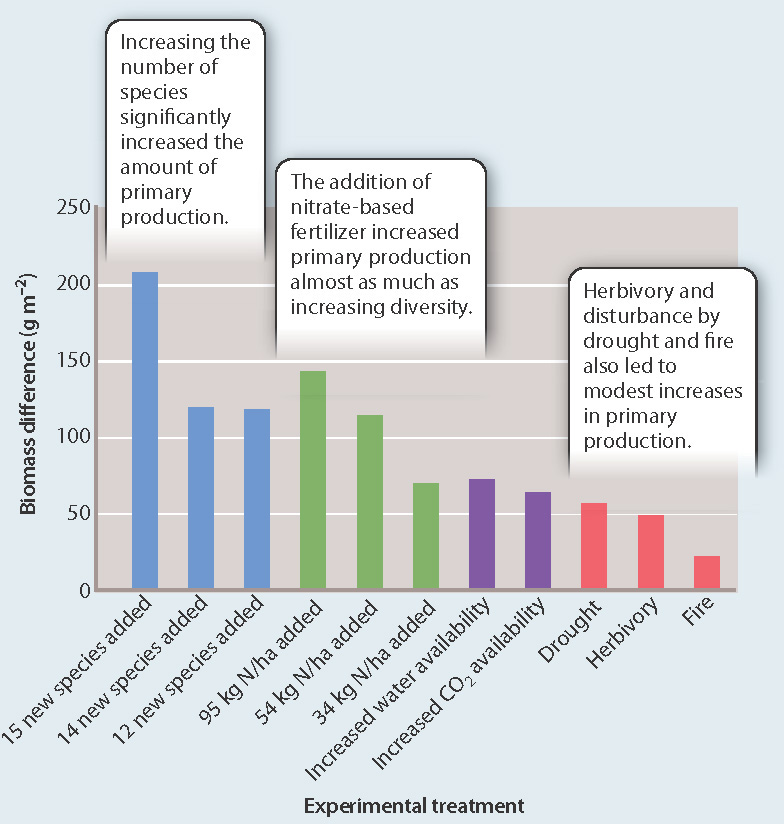47.5 ECOSYSTEMS
A community of organisms and the physical environment it occupies together form an ecosystem (Fig. 47.13). The physical and biological components of ecosystems are linked by the processes that cycle nutrients and transfer energy through the system. In Chapter 25, we introduced the concepts of the food web and the trophic pyramid as depictions of carbon cycling and energy flow through ecosystems, respectively. Now we can revisit these concepts, understanding them as reflections of the functional properties of individual species and the mutualisms, antagonisms, and other interactions among species within a community.

47.5.1 Species interactions result in food webs that cycle carbon and other elements through ecosystems.
Of all the interactions observed among species, none are more prominent than predation and herbivory. Heterotrophic organisms, from bacteria to blue whales, obtain carbon and other elements needed for growth from other organisms. Thus, when a sea star preys on a mussel, we can view this interaction both as an antagonism between two species and as a link in the carbon cycle. Heterotrophic organisms commonly consume other heterotrophs, but, ultimately, ecosystem function depends on autotrophs—photosynthetic or chemosynthetic organisms that can form organic molecules by the reduction of carbon dioxide available in the physical environment (Chapter 6).
In ecology, photosynthetic and chemosynthetic organisms are known as primary producers, organisms that take up inorganic carbon, nitrogen, phosphorus, and other compounds from the environment and convert them biochemically into proteins, nucleic acids, lipids, and more (Chapter 25). Consumers, heterotrophic organisms of all kinds, depend on primary production, directly consuming primary producers or consuming those that do. Predators hunt and eat prey, herbivores eat plants, and parasites infect their hosts.

The various species present in an ecosystem can therefore be placed in an order that describes how one organism feeds on another, moving carbon through the system. This order is commonly depicted as linear, and it is called a food chain. In nature, however, every species is connected to many others. Many ecologists also stress that most communities contain species that are omnivorous, eating both plants and animals. For these reasons, the movement of carbon through an ecosystem is more realistically thought of as a food web (Fig. 47.14).
An organism’s typical place in a food web is its trophic level (Fig. 47.14). The first trophic level consists of primary producers; consumers occupy the levels above the first trophic level. At the second trophic level are primary consumers; these are the herbivores, organisms that eat plants or other primary producers. Predators, organisms that eat other consumers, are secondary consumers, at the third trophic level, and potentially higher levels as well. Top or apex predators, which have few, if any, natural predators, occupy the highest trophic level. Parasites exploit all levels of the system, obtaining carbon and other nutrients from primary producers and consumers alike. Finally, there are the all-important decomposers and detritivores. Decomposers feed on the dead cells or bodies of other organisms, and detritivores do much the same, consuming partially decomposed plants or animals in soil or sediment, as well as organic compounds in feces. These organisms return carbon dioxide and other inorganic compounds to the environment, completing the cycle of elements through the ecosystem.
47.5.2 Species interactions form trophic pyramids that transfer energy through ecosystems.
The interactions among species transfer energy as well as carbon and other elements through ecosystems. Unlike carbon, energy does not cycle through an ecosystem, and so new energy must continually be harvested from the environment to sustain the community. In essentially all ecosystems where sunlight is available, photosynthesis lies at the heart of ecosystem function. Plants, algae, and photosynthetic bacteria capture energy from the sun and use it to synthesize organic molecules. Where sunlight is absent, especially in the vast depths of ocean, Bacteria and Archaea fuel primary production by chemical reactions.
Some of the energy harvested by primary producers is stored as chemical bonds in organic molecules such as carbohydrates (Chapter 8) and so will be available to organisms at the next trophic level. Some, however, will be dissipated as heat or used to do work. Because building organic molecules is not 100% energy efficient, and because organisms at one trophic level rarely consume all the resources in the level below them, biomass and the energy it represents generally decrease from one trophic level to the next. The result is a trophic pyramid.
The broad base of biomass available in primary producers decreases steadily with each ascending step in trophic level (Fig. 47.15). In general, about 10% of the energy and biomass available at one trophic level is passed to the next. So 1000 kg of grass biomass will support about 100 kg of lemmings (about 400 animals), and that, in turn, will support 10 kg of small predators like foxes. At the apex of the pyramid, we find a single kilogram of eagle tissue. In this way, primary production exerts a powerful influence on the rest of the community. To get more foxes and eagles, we would need more photosynthesis.

47.5.3 Light, water, nutrients, and diversity all influence rates of primary production.
If most ecosystems rest on a base of primary production, what controls rates of photosynthesis? Sunlight plays a role. Although all ecosystems, from polar deserts to equatorial forests, receive the same total number of hours of sunlight annually, the intensity of solar radiation declines from the equator to the poles because of Earth’s curvature. Seasonality also becomes more pronounced toward the poles, influencing the ability of primary producers to sustain growth throughout the year at higher latitudes.
In addition to sunlight, in most ecosystems water and nutrients govern rates of primary production. In Chapter 29, we saw that plants perform a physiological balancing act, opening their stomata to allow carbon dioxide into leaves but losing water vapor as a result. Because photosynthesis requires both carbon dioxide and water, photosynthetic rate—the amount of CO2 fixed into organic matter in a given time interval—is closely tied to water availability. Lack of regular access to water limits the productivity of photosynthetic organisms in deserts and seasonally arid landscapes, explaining why irrigation increases crop yields in places like southern California, northern Africa, and the Middle East.
Even where water is not limiting, rates of photosynthesis are constrained by the availability of nutrients. This is why fertilizer generally increases crop yields (Chapter 29). Plants, algae, and photosynthetic bacteria all need nitrogen, phosphorus, sulfur, iron, and an array of trace elements to grow, and any one of these can limit primary production. In forests, nitrogen is commonly the soil nutrient that is least abundant relative to the needs of plants. In the open ocean, nitrogen can also be limiting, but commonly it is a scarcity of phosphorus that limits photosynthesis. And in some parts of the ocean, nitrogen and phosphorus are both present in abundance, but primary production is still limited—in this case by iron, needed for many enzymes and electron transport molecules. The idea that primary production is limited by the nutrient that is least available relative to its use by primary producers is called Liebig’s Law of the Minimum, after Justus von Liebig, a nineteenth-century German scientist who first popularized the concept.
Biological diversity in a given region is, in some ways, a result of high productivity. We have seen that the population sizes of predators depend on prey population size, which depends on primary production, and greater primary production also means a greater variety of plants of different sizes and kinds that can support a greater variety of herbivorous animals. While this suggests that high productivity can foster high diversity, recent experiments show that the reverse may also be true: Biological diversity may itself play an important role in ecosystem productivity (Fig. 47.16).
FIG. 47.16Does species diversity promote primary productivity?

BACKGROUND The different plant species found in communities have combinations of leaves, stems, and roots that tap different sources of water and nutrients in the soil and capture light at different levels of sun and shade. Do the differences among plant species result in higher levels of primary production than would be possible with fewer species?
HYPOTHESIS Plant diversity promotes primary production within a community.
EXPERIMENT Ecologist David Tilman conducted a long-term experiment in Minnesota, seeding each of 11 plots with 1, 2, 4, or 16 grassland species, and controlling each plot’s amount of nutrients, water, and carbon dioxide, as well as manipulating the plots’ exposure to herbivory and disturbance by fire. The primary production of each plot was measured annually for up to 23 years.
RESULTS The graph shows that the addition of nitrogen fertilizer [quantified as kg of N per hectare (ha)] increased primary production significantly, and additional water, higher CO2, herbivory, and disturbance also resulted in at least a modest increase in productivity. The difference in primary production between high-diversity (16 species) and low-diversity (1, 2, or 4 species) plots was at least as great as the largest additions of fertilizer—and much greater than any of the other treatments.
CONCLUSION The hypothesis was supported: In the grassland community under study, species diversity promotes primary production.
FOLLOW-UP WORK Researchers continue to study the ecosystem effects of species diversity, steadily accumulating data that show the importance of conserving the species diversity found in nature.
SOURCE Tilman, D., P. B. Reich, and F. Isbell. 2012. “Biodiversity Impacts Ecosystem Productivity as Much as Resources, Disturbance, or Herbivory.” Proceedings of the National Academy of Sciences USA, 109:10394–10397.
Quick Check 4
What is the difference between a community and an ecosystem?